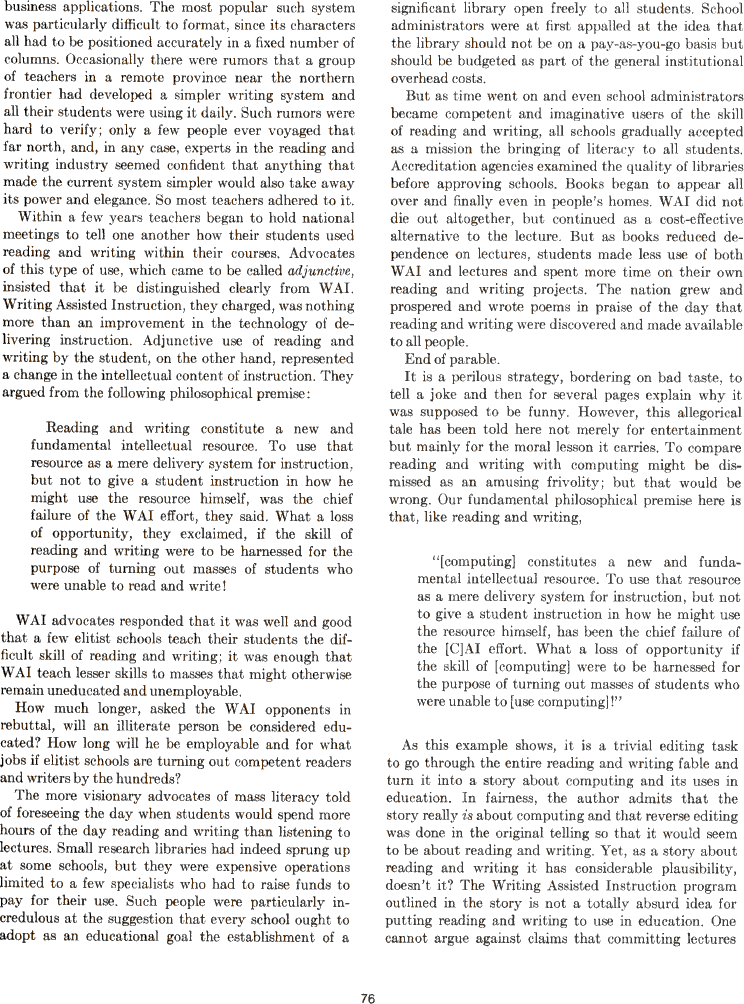The Best of Creative Computing Volume 2 (published 1977)
Should the Computer Teach the Student, or Vice-Versa?

business applications. The most popular such system was particularly difficult
to format, since its characters
all had to be positioned accurately in a fixed number of columns. Occasionally
there were rumors that a group
of teachers in a remote province near the northern frontier had developed a
simpler writing system and all their students were using it daily. Such rumors
were hard to verify; only a few people ever voyaged that far north, and, in any
case, experts in the reading and writing industry seemed confident that anything
that made the current system simpler would also take away its power and
elegance. So most teachers adhered to it.
Within a few years teachers began to hold national meetings to tell one another
how their students used reading and writing within their courses. Advocates of
this type of use, which came to be called adjunctive,
insisted that it be distinguished clearly from WAI. Writing Assisted
Instruction, they charged, was nothing
more than an improvement in the technology of delivering instmction. Adjunctive
use of reading and writing by the student, on the other hand, represented a
change in the intellectual content of instruction. They argued from the
following philosophical premise:
Reading and writing constitute a new and fundamental intellectual resource. To
use that resource as a mere delivery system for instruction, but not to give a
student instruction in how he might use the resource himself, was the chief
failure of the WAI effort, they said. What a loss of opportunity, they
exclaimed, if the skill of reading and writing were to be harnessed for the
purpose of turning out masses of students who
were unable to read and write!
WAI advocates responded that it was well and good that a few elitist schools
teach their students the difficult skill of reading and writing; it was enough
that WAI teach lesser skills to masses that might otherwise remain uneducated
and unemployable.
How much longer, asked the WAI opponents in rebuttal, will an illiterate person
be considered educated? How long will he be employable and for what jobs if
elitist schools are turning out competent raders and writers by the hundreds?
The more visionary advocates of mass literacy told of foreseeing the day when
students would spend more hours of the day reading and writing than listening to
lectures. Small research libraries had indeed sprung up at some schools, but
they were expensive operations limited to a few specialists who had to raise
funds to pay for their use. Such people were particularly incredulous at the
suggestion that every school ought to adopt as an educational goal the
establishment of a significant library open freely to all students. School
administrators were at first appalled at the idea that the library should not be
on a pay-as-you-go basis but
should be budgeted as part of the general institutional overhead costs.
But as time went on and even school administrators became competent and
imaginative users of the skill of reading and writing, all schools gradually
accepted as a mission the bringing of literacy to all students.
Accreditation agencies examined the quality of libraries before approving
schools. Books began to appear all
over and finally even in people's homes. WAI did not die out altogether, but
continued as a cost-effective
altemative to the lecture. But as books reduced dependence on lectures, students
made less use of both WAI and lectures and spent more time on their own reading
and writing projects. The nation grew and prospered and wrote poems in praise of
the day that reading and writing were discovered and made available to all
people.
End of parable.
It is a perilous strategy, bordering on bad taste, to tell a joke and then for
several pages explain why it
was supposed to be funny. However, this allegorical tale has been told here not
merely for entertainment
but mainly for the moral lesson it carries. To compare reading and writing with
computing might be dismissed as an amusing frivolity; but that would be wrong.
Our fundamental philosophical premise here is that, like reading and writing,
"[computing] constitutes a new and fundamental intellectual resource. To use
that resource as a mere delivery system for instruction, but not to give a
student instruction in how he might use the resource himself, has been the chief
failure of the [C]AI effort. What a loss of opportunity if the skill of
[computing] were to be harnessed for the purpose of turning out masses of
students who were unable to [use computing]!"
As this example shows, it is a trivial editing task to go through the entire
reading and writing fable and
turn it into a story about computing and its uses in education. In fairness, the
author admits that the story really is about computing and that reverse editing
was done in the original telling so that it would seem
to be about reading and writing. Yet, as a story about reading and writing it
has considerable plausibility,
doesn't it? The Writing Assisted Instruction program outlined in the story is
not a totally absurd idea for
putting reading and writing to use in education. One cannot argue against claims
that committing lectures


